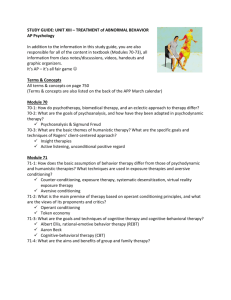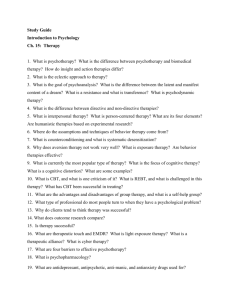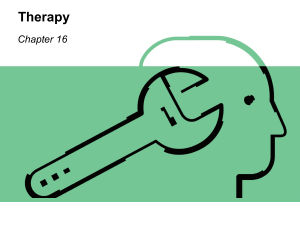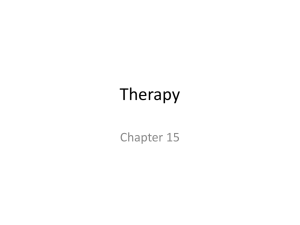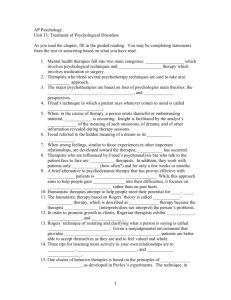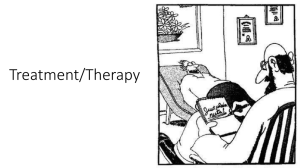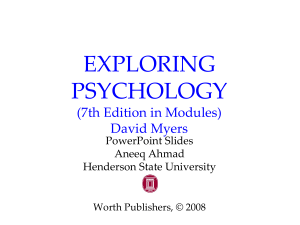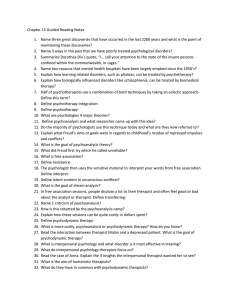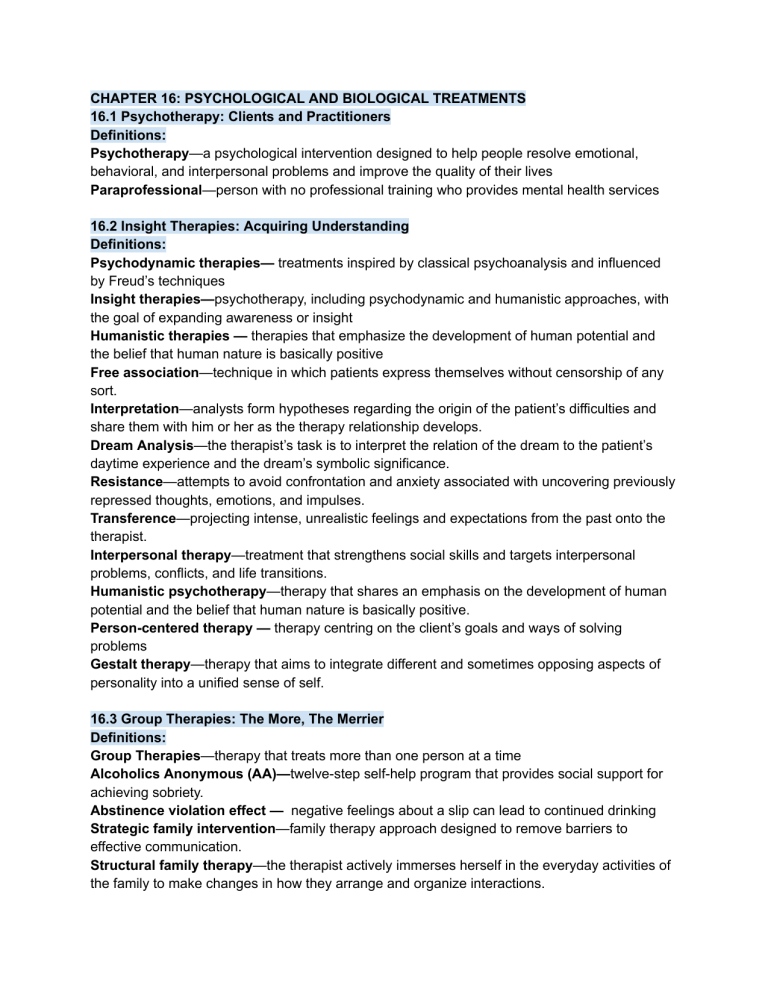
CHAPTER 16: PSYCHOLOGICAL AND BIOLOGICAL TREATMENTS 16.1 Psychotherapy: Clients and Practitioners Definitions: Psychotherapy—a psychological intervention designed to help people resolve emotional, behavioral, and interpersonal problems and improve the quality of their lives Paraprofessional—person with no professional training who provides mental health services 16.2 Insight Therapies: Acquiring Understanding Definitions: Psychodynamic therapies— treatments inspired by classical psychoanalysis and influenced by Freud’s techniques Insight therapies—psychotherapy, including psychodynamic and humanistic approaches, with the goal of expanding awareness or insight Humanistic therapies — therapies that emphasize the development of human potential and the belief that human nature is basically positive Free association—technique in which patients express themselves without censorship of any sort. Interpretation—analysts form hypotheses regarding the origin of the patient’s difficulties and share them with him or her as the therapy relationship develops. Dream Analysis—the therapist’s task is to interpret the relation of the dream to the patient’s daytime experience and the dream’s symbolic significance. Resistance—attempts to avoid confrontation and anxiety associated with uncovering previously repressed thoughts, emotions, and impulses. Transference—projecting intense, unrealistic feelings and expectations from the past onto the therapist. Interpersonal therapy—treatment that strengthens social skills and targets interpersonal problems, conflicts, and life transitions. Humanistic psychotherapy—therapy that shares an emphasis on the development of human potential and the belief that human nature is basically positive. Person-centered therapy — therapy centring on the client’s goals and ways of solving problems Gestalt therapy—therapy that aims to integrate different and sometimes opposing aspects of personality into a unified sense of self. 16.3 Group Therapies: The More, The Merrier Definitions: Group Therapies—therapy that treats more than one person at a time Alcoholics Anonymous (AA)—twelve-step self-help program that provides social support for achieving sobriety. Abstinence violation effect — negative feelings about a slip can lead to continued drinking Strategic family intervention—family therapy approach designed to remove barriers to effective communication. Structural family therapy—the therapist actively immerses herself in the everyday activities of the family to make changes in how they arrange and organize interactions. 16.4 Behavioural and Cognitive-Behavioral Approaches: Changing Maladaptive Actions and Thoughts Definitions: Behavioral therapists—therapist who focuses on specific problem behaviors and current variables that maintain problematic thoughts, feelings, and behaviors Ecological momentary assessment — assessment of throughs, emotions, and behaviors that arise in the moment in situations in which they occur in everyday life Systematic desensitization—patients are taught to relax as they are gradually exposed in a stepwise manner to what they fear. Exposure therapy—therapy that confronts patients with what they fear, with the goal of reducing that fear. reciprocal inhibition — principle that says that patients can’t experience two conflicting responses simultaneously. Dismantling — research procedure for examining the effectiveness of isolates components of a larger treatment Flooding therapies — when therapists expose clients to images of the stimuli they fear the most for prolonged periods, often for an hour or even several hours Response prevention —- crucial component of flooding, a technique in which therapists prevent clients from performing their typical avoidance behaviors Participant modeling—technique in which the therapist first models a problematic situation and then guides the patient through steps to cope with it unassisted Token economy —- method in which desirable behaviors are rewarded with tokens that clients can exchange for tangible rewards Aversion therapies—treatment that uses punishment to decrease the frequency of undesirable behaviors. Cognitive behavioral therapies—treatment that attempts to replace maladaptive or irrational cognitions and behaviors with more adaptive, rational ones. Stress inoculation training — therapists teach clients to prepare for and cope with future stressful like events Third-wave therapies — represent a shift from both the first (behavioral) and the second (cognitive) waves of the cognitive-behavioral traditions Dialectic— the apparent contradiction between opposing tendencies — of changing problematic behavior and accepting it Eclectic approaches — treatments that integrate techniques and theories from more than one existing approach 16.5 Is Psychotherapy Effective? Definitions: Meta-analysis —- a statistical method that helps researchers interpret large bodies of psychological literature Nonspecific factors — those that cut across any or most therapies Specific factors — those that characterize only certain therapies Empirically supported therapies—treatments for specific disorders supported by high quality scientific evidence 16.6 Biomedical Treatments: Medications, Electrical Stimulation, and Surgery Definitions: Psychopharmacotherapy—use of medications to treat psychological problems Electroconvulsive therapy—patients receive brief electrical pulses to the brain that produce a seizure to treat serious psychological problems. Psychosurgery—brain surgery to treat psychological problems Polypharmacy — prescribing many medications (sometimes five or more) at the same time 16.1 Notes -people grabble with specific problems in psychotherapy, but they also contend frequently with feelings of helplessness, social isolation, and a sense of failure Who Seeks and Benefits from Treatment? 1. Gender, Ethnicity, and Cultural: Differences in Entering Treatment a. Females are more likely to seek treatment than males, even though both sexes benefit equally. b. Therapy can be very costly for those without health insurance, and some health plans don’t include mental health coverage. c. Members of many racial and ethnic minority groups, particularly Asians and Hispanics, are less likely to seek mental health services than Caucasians, perhaps because of the stigma surrounding psychotherapy in these groups. d. Culturally sensitive psychotherapists tune their interventions to patients’ cultural values and the difficulties they encounter in adapting to a dominant culture that, at times, is vastly different from their own. e. There is no consistent evidence that therapy outcome is enhanced by patient-therapist ethnic matches or gender matches. 2. Reaping Benefits from Treatment a. The effectiveness of therapy depends on the nature of the problems and of the Individuals. b. Research shows that those with more temporary situational problems such as relationship upheavals tend to have better outcomes from psychotherapy on average than those with longer standing and more pervasive problems. Who Practices Psychotherapy? 1. Clinical psychologists, psychiatrists, mental health counselors, and clinical social workers with professional degrees and licenses are the mainstays of the mental health profession 2. Unlicensed religious, vocational, and rehabilitation counselors are therapists, some with advanced degrees in fields other than psychology, also provide services. 3. Professional Versus Paraprofessionals a. In most provinces, the term therapist isn’t illegally protected; therefore, anyone can offer psychological treatment. b. Therapists who give patient hope, empathy, advice, support, and opportunities for new learning experiences can be effective regardless of their training background. 4. What Does It Take to Be an sessionEffective Psychotherapist? a. Effective therapists are likely to be warm and direct, establish a positive working relationship with patients, and tend not to contradict patients. b. Effective therapists also select important topics to focus on in sessions and match their treatments to the needs and characteristics of patients. c. The choice of therapists is every bit as important as the choice of therapy 16.2 Notes — Insight Therapies: Acquiring Understanding A. Psychodynamic therapists refers to both Freudian therapists and those influenced by Freud’s techniques. B. Insight therapies -humanistic therapies -> reject the interpretive techniques of psychoanalysis. They strive to understand clients’ inner worlds through empathy and focus on clients’ thoughts and feelings in the present moment C. Psychoanalytic and Psychodynamic Therapies: Freud’s Legacy 1. Psychodynamic therapists share the following three beliefs: a. The causes of abnormal behaviors stem from traumatic or other adverse childhood experiences. b. They strive to analyze: i. Distressing thoughts and feeling patients avoid. ii. Wishes and fantasies. iii. Recurring themes and life patterns. iv. Significant past events. v. The therapeutic relationship. c. When insight occurs, the symptoms are more likely to disappear 2. Psychoanalysis: Key Ingredients a. According to Freud the goal of psychoanalytic therapy is to make the unconscious conscious. b. He meant making the patient aware of previously repressed impulses, conflicts, and memories that generate psychological distress. c. Psychoanalytic therapy aims to clear away the emotional distortions from past experiences, guilt, and frustrations. d. Psychoanalytic therapists follow the following six approaches: i. Free association ii. Interpretation iii. Dream Analysis iv. Resistance • Therapists minimize resistance by making patients aware they’re unconsciously obstructing therapeutic efforts. v. Transference • Research suggests that we indeed often react to people in our present lives in ways similar to people in our pasts. vi. Work through is the last stage where patients confront and resolve problems, conflicts, and ineffective coping responses in everyday life. 3. Developments in Psychoanalysis: The Neo-Freudian Tradition -Carl Jung -> goal of psychotherapy is individuation (the integration of opposing aspects of the personality into a harmonious “whole” -> the self ) a. Neo-Freudian therapists are more concerned with conscious aspects of the patient’s functioning, as well as recognizing the impact of culture and influences on behavior across the lifespan. b. Neo-Freudians acknowledge the impact of other powerful needs, including love, dependence, power, and status. c. Harry Stack Sullivan contended that the analyst’s proper role is that of participant observer. d. Interpersonal therapy -> IPT has demonstrated success in the treatment of substance abuse and eating disorders. e. Is Insight Necessary? -insight is the crucial ingredient in therapeutic change i. Extensive research shows that understanding our emotional history isn’t required to relieve psychological distress. -> need to engage in working through f. Are Traumatic Memories Repressed? i. Contrary to psychodynamic theory, disturbing events are more memorable and less subject to forgetting. g. Psychodynamic Therapies Evaluated Scientifically i. Freud based his therapeutic observations largely on small samples of wealthy, intelligent, and successful people, rendering their external validity unclear. ii. Freud’s clinical sessions weren’t observed by others or conducted on a systematic basis that permitted examination and replication by others. D. Humanistic Psychotherapy: Achieving Our Potential 1. Humanistic psychotherapy a. Humanistic therapists work to help people overcome the sense of alienation so prevalent in our culture; to develop their sensory and emotional awareness; and to express their creativity and help them become loving, responsible, and authentic. b. Therapists focus on the subjective phenomena patients experience in the present moment. 2. Person-Centered Therapy: Attaining Acceptance a. Carl Rogers exemplified humanistic therapy the best. b. Within this approach, the therapist doesn’t tell patients how to solve their problems, and patients use the therapy hour however they choose. c. Therapists assume that patients will reveal important emotional patterns as the session’s dialogue unfolds. d. Therapist must satisfy three conditions: 1) therapists must be an authentic, genuine person who reveals his or her own reactions to what the patient is communicating 2) express unconditional positive regard, that is, a nonjudgmental acceptance of all feelings that patient is communicating 3) The therapists must relate to patients with empathic understanding. -person-centered interviewing techniques, including warmth and empathy, reflective listening, unconditional acceptance, and avoiding confrontation, lie at the heart of motivational interviewing (session geared toward clarifying and bringing forth their reasons for changing- and not changing - their lives) ->helpful in treating alcohol issues, and health relating issues 3. Gestalt Therapy: Becoming Whole a. Gestalt therapy -> Fritz Perls b. Keys to personal growth were accepting responsibility for one’s feelings and maintaining contact with the here and now. c. Example of a Gestalt therapy technique is the two-chair technique 4. Humanistic Therapies Evaluated Scientifically a. The three conditions Rogers specified aren’t the only ways to achieve improvement. b. Establishing a strong alliance is extremely helpful to the ultimate success of therapy. c. The effectiveness of person-centered therapy is inconsistent, with some suggesting it may not help much more than a placebo treatment. 16.3 Notes — Group Therapies: The More, The Merrier 1. Group therapies (Jacob Moreno) are efficient, time saving, and less costly than individual treatment methods and span all major schools of psychotherapy. 2. Group therapy reaches all races, ages, and economic levels, including people who are blind, divorced, experiencing marital problems, struggling with their gender identity, and suffering from alcoholism and eating disorders. 1. Alcoholics Anonymous is the largest organization for treating alcoholics, with more than 1.7 million members worldwide. 2. AA appears to be helpful for some people, yet many of the claims regarding its success aren’t supported by data. 3. AA members who end up in studies are usually the most active participants and received prior professional help. -abstinence violation effect C. Controlled Drinking and Relapse Prevention 1. The behavioral view assumes that excessive drinking is a learned behavior that therapists can modify and control without total abstinence. 2. Programs that teach people skills to cope with stressful life circumstances and tolerate negative emotions are at least as effective as programs such as AA. D. Family Therapies: Treating the Dysfunctional Family System 1. Family therapists see most psychological problems as rooted in a dysfunctional family system. 2. Strategic Family Therapy a. Strategic family intervention b. Strategic therapists acknowledge that families often scapegoat one family member as the problem even though the real difficulties lie within the dysfunctional ways of the family, i.e., communication and problem solving. c. May use “paradoxical requests” 3. Structural family therapy 16.4 Notes — Behavioural and Cognitive-Behavioral Approaches: Changing Maladaptive Actions and Thoughts A. Behavioral therapists 1. The results of behavior therapy are evaluated based on whether there is measurable improvement in target behaviours, i.e., angry outbursts, compulsions, or suicide threats. 2. Behavior therapists use a wide variety of behavioral assessment techniques to pinpoint environmental causes of the person’s problem, establish specific and measurable treatment goals, and devise therapeutic procedures. -clinicians have used monitoring techniques, ecological momentary assessment to: a) Increase clients’ awareness of the frequency and circumstances associated with a behavior they hope to change (like pathological alcohol use) b) To assist therapists with assessment and treatment planning i) Considers clients’ gender, race, socioeconomic status, culture, sexual orientation, and ethnic factors, interpersonal relationships, drug use B. Systematic Desensitization and Exposure Therapies: Learning Principles in Action 1. Systematic desensitization (Joseph Wolpe)2. Exposure therapy 3. How Desensitization Works: One Step at a Time (Table 16.3) a. Systematic desensitization is based on the principle of reciprocal inhibition, which says that patients can’t experience two conflicting responses simultaneously. b. The following steps occur in systematic desensitization: i. Therapist teaches the patient to relax. ii. Patient constructs an anxiety hierarchy. iii. Patient is asked to imagine the first scene, and iv. Patient is shown next anxiety-producing scene, and is asked to relax v. Therapist reintroduces the scene that preceded the one that caused the anxiety. vi. Process continues until the patient can confront frightening scenes without anxiety. c. Desensitization can also occur in vivo, that is in real life. d. The Effectiveness of Systematic Desensitization i. Systematic desensitization is effective for a wide range of phobias and can help people avoid anxiety that contributes to insomnia, speech disorders, asthma attacks, nightmares, and some cases of problem drinking. Dismantling helps to uncover the effectiveness of these treatments. 4. Flooding and Virtual Reality Exposure a. Flooding therapists jump right to the top of the anxiety hierarchy and expose patients to images of the stimuli they fear the most for prolonged periods. b. The flooding therapist provokes anxiety repeatedly in the absence of actual negative consequences, so the extinction of the fear can occur. c. A crucial component of flooding is response prevention, in which therapists prevent patients from performing their typical avoidance behaviors. 5. Exposure: Fringe and Fad Techniques a. Unsupported therapies include Thought Field Therapies (TFT) (Roger Callahan) b. The energy blocks or TFT are not measurable, the theoretical claims of TFT are unfalsifiable. C. Modelling in Therapy: Learning by Watching 1. Participant modeling 2. Assertion Training a. Modeling is an important component of assertion and social skills training programs designed to help patients with social anxiety. 3. Behavioral Rehearsal a. Behavioral rehearsal is used in patient modeling techniques, where the patient engages in role-playing with a therapist to learn and practice new skills. b. The patient has an opportunity to model assertive behaviors, therapist and patient reverse roles, with the therapist playing the patient’s role. D. Operant and Classical Conditioning Procedures 1. Token economy programs shape, maintain, or alter behaviors by the consistent application of operant conditioning principles. a. One essential feature of token economies is that certain behaviors are consistently rewarded with tokens that patients can later exchange for more tangible rewards, whereas non-favorable behaviors are ignored or punished. 2. Aversion therapies E. Cognitive-behavioral and Third-Wave Therapies: Learning to Think and Act Differently 1. Cognitive behavioral therapies a. The therapies share the following core assumptions: 1) cognitions can be identified and measured, 2) cognitions are the key players in both healthy and unhealthy psychological functioning, 3) irrational beliefs can be replaced by more rational and adaptive cognitions. -At 42% of clinical psychologists, this is the most popular theoretical orientation in Canada. 2. The ABCs of Rational Emotive Behavioural Therapy (see Figure 16.4) a. Albert Ellis advocated rational emotive therapy (RET), more recently named rational emotive behavioral therapy (REBT). b. Ellis argued that we respond to an activating (internal or external) event with a range of emotional and behavioral consequences. c. The crucial difference in how we respond to the same objective events stems largely from differences in our belief systems. d. Some beliefs are rational and promote self-acceptance and others are irrational and are associated with unrealistic demands about the self, other people, and life conditions e. According to Ellis, our vulnerability to psychological disturbance is a product of the frequency and strength of our irrational beliefs. f. REBT therapists encourage patients to actively dispute their irrational beliefs and adopt more rational beliefs to increase adaptive responses. 3. Other Cognitive-Behavioral Approaches a. Aaron Beck’s cognitive therapy emphasizes identifying and modifying distorted thoughts and long-held negative core beliefs. b. Researchers have found Beck’s approach helpful for people with depression and perhaps even bipolar disorder and schizophrenia. 4. Acceptance: The Third Wave of Cognitive-Behavioural Therapy a. Acceptance and commitment therapy incorporates techniques from a wide variety of approaches that encourage patients to accept their thoughts and feelings while making changes in their behaviors. 5. CBT and Third Wave Approaches Evaluated Scientifically a. They’re more effective than no treatment or placebo treatment. b. They’re at least as effective, and in some cases more effective, than psychodynamic and person-centered therapies. c. Therapists can combine them effectively with other forms of treatment. d. CBT and behavioral treatments are about equally effective for most problems. e. Third wave approaches have scored successes in treating a variety of disorders, including depression and alcoholism 16.5 Notes — Is Psychotherapy Effective? A. The Dodo Bird Verdict: Alive or Extinct 1. Some analyses suggest that a wide range of psychotherapies are about equal in their effects. The common technique today is the meta analysis. 2. Studies with experienced therapists who’ve practiced behavioral, psychodynamic, and person-centered approaches have found that all are more successful in helping patients compared with no treatment but no different from each other in their effects. 3. Other researchers contend the dodo bird verdict is extinct. 4. Five to ten percent tend to become worse following psychotherapy, and some may have become worse because of psychotherapy Table 16.5 — List of Potentially Harmful Therapies Therapy Intervention Potential Harm Scared Straight Adolescents at risk for criminal behavior are couples in seminars with prison inmates May increase the risk for conduct disorder Coercive restraint Includes rebirthing and being held down by the therapist Injury, suffocation, death Grief counseling Additional or excessive grief counseling for those adequately coping with their grief Increase in depression Youth interrogations Children and adolescents are continually questioned about possible abuse False accusations of child abuse 5. Many therapies are effective, and many do about equally well probably because most share certain features like empathetic listening and offer new ways of thinking and behaving. B. How Different Groups of People Respond to Psychotherapy 1. Not much is known as to how certain segments of the population respond to psychotherapy. C. Nonspecific Factors 1. One probable reason why many therapies are comparable in effectiveness is that certain common factors are responsible for improvements. 2. Common factors include: a. Empathic listening, b. Instilling hope, c. Establishing a strong emotional bond with patients, d. Providing a clear theoretical rationale for treatment, e. Implementing techniques that offer new ways of thinking, feeling, and behaving. D. Empirically Supported Treatments 1. Empirically supported therapies a. Behavioral therapy and cognitive-behavioral therapy have emerged as ESTs for depression, anxiety, obesity, relationship problems, sexual dysfunction, and alcohol problems. b. The movement to develop lists of ESTs is controversial and researchers contend that the research literature isn’t sufficiently developed to conclude that certain treatments are clearly superior to others for certain disorders c. Because current data suggest that at least some treatments are superior to others for some disorders, practitioners have an ethical obligation to rely on ESTs unless there’s a compelling reason not to. 16.6 Notes — Biomedical Treatments: Medications, Electrical Stimulation, and Surgery A. Psychopharmacotherapy: Targeting Brain Chemistry 1. Psychopharmacotherapy— a. For virtually every psychological disorder treated with psychotherapy, there’s an available medication. b. By 1970, it was unusual for any patient with schizophrenia not to be treated with Thorazine or another of the major tranquilizers. c. Researchers discovered that the emotional storms that plague people with bipolar disorder could be tamed with Lithium, Tegretol, and a new generation of mood stabilizer. d. Many medications may exert their effects largely by affecting the sensitivity of receptors rather than the levels of neurotransmitters. e. There’s no scientific evidence for an “optimal” level of serotonin or other neurotransmitters in the brain. 2. Cautions to Consider: Dosage and Side Effects a. Pharmacotherapy isn’t a cure-all and virtually all medications have side effects including nausea, drowsiness, weakness, fatigue, and impaired sexual performance. b. Most adverse reactions are reversible when medications are discontinued or when their dosage is lowered. c. Tardive dyskinesia is a serious side effect of some antipsychotic medications and includes grotesque involuntary movements of the facial muscles and mouth and twitching of the neck, arms, and legs. d. One Dose Doesn’t “Fit All”: Differences in Response to Medication i. Weight, age, and even racial differences often affect drug response. ii. African Americans tend to require lower doses of certain antianxiety and antidepressant drugs and have a faster response than do Caucasians, and Asians metabolize these medications more slowly than do Caucasians. iii. Physicians try to determine the lowest dose possible to achieve positive results and minimize unpleasant side effects. e. Medications on Trial: Harmful and Overprescribed? i. North American drug regulators now require drug manufacturers to include warnings of possible suicide risk on the labels of SSRIs. ii. A major area of concern is polypharmacy: prescribing many medications— sometimes five or more—at the same time. iii. An area of public concern regarding drug treatments is over prescription. iv. Since the early 1990s, the number of prescriptions for ADHD has increased fourfold. 3. Evaluating Psychopharmacotherapy -ppolypharmacy a. Research suggests that combining medication with psychotherapy is warranted for treating schizophrenia, bipolar disorder, long-term major depression, and major depression with psychotic symptoms. B. Electrical Stimulation: Conceptions and Misconceptions 1. Electroconvulsive therapy 2. Electroconvulsive Therapy: Fact and Fiction a. This is recommended for individuals with serious depression, bipolar disorder, schizophrenia, and severe catatonia, and only then as a last resort when psychotherapy and pharmacotherapy have failed. b. Even if patients report feeling better after ECT, they don’t always show evidence of parallel changes on objective measures of depression and mental functioning. c. ECT can create short-term confusion and cloud memory; memory is restricted to events that occur right before the treatment and generally subsides within a few weeks. C. Psychosurgery: An Absolute Last Report 1. Psychosurgery a. To most critics, the benefits of psychosurgery rarely, if ever, outweighed the costs of impairing memory, diminishing emotion and creativity, and the risks of brain surgery. b. In the 1960s surgeons ushered new forms of psychosurgery in which small lesions were created in the amygdala or in other parts of the limbic system, which play a key role in controlling emotions. c. Primitive procedures were replaced with ultrasound, electricity, freezing of tissues, and implants of radioactive materials. d. Today surgeons sometimes perform psychosurgery as an absolute last resort for patients with a handful of conditions, such as severe obsessive-compulsive disorder, major depression, and bipolar disorder. 2. The IRB helps ensure that a) there’s a clear rationale for the operation, b) the patient has received an appropriate preoperative and postoperative evaluation, c) the patient has consented to the operation, and d) the surgeon is competent to conduct the procedure

